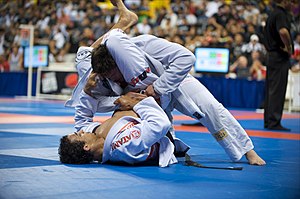Perhaps no other position best symbolizes Brazilian Jiu Jitsu than “the guard.” Most BJJ athletes will spend a great deal of time drilling and sparring to sharpen their skills and create a guard game that will both frustrate and, hopefully, eventually wear their opponent down until they are able to sweep or submit the opponent who is unlucky to end up in their guard.
When I work one-on-one with students and answer questions about the guard I often have to make the person take a few steps back and look at what they are doing, why they are doing it, and when they are doing it. As a new blue belt I remember the frustration I would feel not being able to submit a lower belt when they were in my guard. This frustration would lead to panic after I was unable to submit them and they eventually passed my guard, got mounted on me, and, in more than a few occasions, submitted me. What I eventually realized was that I had a “list” in my head of all the sweeps and submissions I knew and I would run down this list as soon as someone ended up in my guard. I assumed that since I was a higher rank I would know more moves than they did, and I would eventually submit them when I attacked them with a move they didn’t know. Same with sweeps… I would work through all my submissions first and then I would try all my sweeps if I was unable to catch my opponent.
Timing is Everything
There are a few things to keep in mind as you attack from and develop your guard. First, as with almost anything else in Jiu Jitsu, timing is everything. The best way to use your timing is to execute your sweeps and submissions off the movement of your opponent. By doing this, you make it hard for your opponent to stop a move since they are already moving in a certain direction. Also, setting up attacks off of your opponent’s movements allows you to use less strength and therefore flow from one move to the next effortlessly. I often use the analogy of a good guard being similar to being trapped in a net. A net’s effectiveness is due to the fact that it’s loose, and envelops its prey. The more the prey struggles in a net, the more it entangles itself. Resist the urge to force moves while in the guard. Learn to set up your opponent by attacking with one move so that you can get them to move or react a certain way. Then use that movement to set up your next attempt.
Check Mate
An effective guard should be the same way… Every move your opponent makes should place them in a worse position, until their last move leads to one final submission. It’s this mentality and approach that leads many to refer to Brazilian Jiu Jitsu as a “chess match.” In chess your goal is to maneuver your pieces in such a way, strategically, that your opponent has no move, offensive or defense, to counter with (i.e. check mate). Jiu Jitsu is the same.
So, how do you practice this? The first thing you must do is let loose of any motivation to catch your opponent. You should still try to put your opponent in submissions, but you should focus on letting off just enough to allow your opponent to escape. For obvious reasons this seems counter intuitive to what most people focus on in the guard but think of the reasoning… By letting them escape by whatever means they think is right, you get the opportunity to see, feel and learn what people will do when caught in a bad position. I recently read an interview with Marcelo Garcia where he says that he learns most by rolling with white and blue belts. Obviously Marcelo could catch these lower belts with almost anything he wants. Instead, he lets them escape positions so he can see how a person will react when getting caught to study their movements. This is what builds your timing. Jiu Jitsu is what happens in between moves and positions, and by learning to anticipate your opponent’s next move, you can better develop your timing to a point where you are able to be one move ahead of your opponent and get them in the most vulnerable position possible… Check mate.

